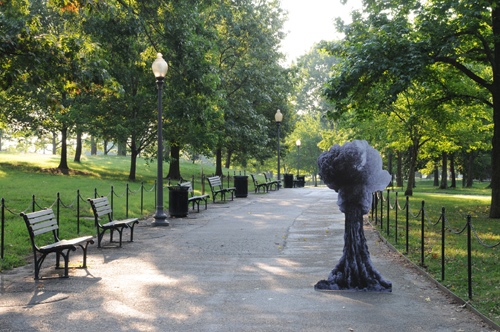
Joe-1 Cruising in Washington, DC (Near Lincoln Memorial 3)
February 15th – March 16th 2013 Winkleman Gallery 621 West 27th Street New York, NY 10001
Opening Reception and Book Party: Friday, February 15, 2013, 6-8 PM
Winkleman Gallery is very pleased to present Homosexuality Is Stalin’s Atom Bomb to Destroy America, our third solo exhibition by New York-based artist Yevgeniy Fiks. Taking its title from a 1953 article by the Cold Warrior and pundit Arthur Guy Mathews, this exhibition explores the historical and ideological links between anti-Communism and homophobia in the United States, as well as the intersections between Communism and sexual identity as it played out during the 20th century. Works in the exhibition range from dry factuality to humor, and farce, and posit the 20th century queerness as the shared Other of the Communism-Capitalism dichotomy, while tracing the uneasy yet tangible historical links between the early 20th century Communist activism and the gay rights movement of the second half of the century.
The exhibition delves into the interlocking histories of the “Red” and “Lavender” scares during the McCarthy-era, when anti-Communist and anti-gay sentiments were fused together in the Cold War witch-hunt rhetoric. Pundits and government officials went as far as envisioning a sinister conspiracy: the Soviet Union is promoting homosexuality as a tool to destroy America. Concurrently, the federal government purged homosexuals that it employed, calling them “security risks”—vulnerable of being blackmailed by Soviet agents into working for them. Ironically, in response to and mirroring its ideological enemy, the American Communist Party also purged known gays from its ranks—marking them as “security risks”—for fear that gay Communists were vulnerable to blackmail and could become informants for the Feds. The official charter of the Communist Party USA even before its 1950s anti-gay purge strictly prohibited gays from membership, adhering to the policies of the Communist Party of the Soviet Union where homosexuality was officially criminalized under Stalin and stigmatized as a “capitalist degeneracy.”
Works in the exhibition include Stalin’s Atom Bomb a.k.a. Homosexuality, a series of prints that highlights paranoid anti-communist and anti-gay quotations from American politicians and pundits of the era. Another series, Joe-1 Cruising in Washington, DC includes photographs of a six-foot cutout of the 1949 Soviet nuclear test explosion RDS-1—codenamed in the US as “Joe-1″—posing, in 2012, at locations that had been popular gay cruising sites in Washington D.C. circa 1930s-1950s. The Security Risk Map of Manhattan maps gay cruising and Communist meeting sites of the 1930-1950s, presenting an open ended question about the “conspiracy” and overlap between the two groups.
Two installations focus on a particular historical figure whose life epitomized this ironic and widely unknown intersection of policies. The piece History of the CPUSA (Harry Hay) consists of a 1952 edition of History of the Communist Party of the United States by William Z. Foster, with inserts about the life and work of Harry Hay (1912–2002). Harry Hay was a communist activist who was forced out of the CPUSA during the McCarthy era, and who later became one of the founders of the gay rights movement in the United States. The work Marxism and the National Question (Harry Hay) is an installation that consists of Joseph Stalin’s 1942 English edition books, Marxism and the National Question, in which Stalin outlines his definition of national minorities. This book sparked Harry Hay’s groundbreaking concept that “gay” constitute a minority—similar to African-Americans or Jews—and as a separate people they are entitled to civil rights. In a whim of historical irony, Hay appropriated the writings by the oppressive Soviet Thermidorian dictator and turned them into a tool of liberation, laying a foundation for the gay movement in the United States.
About The Artist
Yevgeniy Fiks was born in Moscow in 1972 and has been living and working in New York since 1994. Fiks has produced many projects on the subject of the Post-Soviet dialog in the West, among them: Ayn Rand in Illustration, a series of drawing pairing descriptive text from Atlas Shrugged with uncannily complimentary Soviet Socialist Realism classic artworks; “Lenin for Your Library?” in which he mailed V.I. Lenin’s text “Imperialism: The Highest Stage of Capitalism” to one hundred global corporations as a donation for their corporate libraries; “Communist Party USA,” a series of portraits of current members of Communist Party USA, painted from life in the Party’s national headquarters in New York City; and “Communist Guide to New York City,” a series of photographs of buildings and public places in New York City that are connected to the history of the American Communist movement. Fiks’ work has been shown internationally. This includes exhibitions in the United States at Winkleman and Postmasters galleries (both in New York) Mass MoCA, and the Philadelphia Museum of Modern Art; the Moscow Museum of Modern Art and Marat Guelman Gallery in Moscow; Sala de Arte Público Siqueiros in Mexico City, and the Museu Colecção Berardo in Lisbon. His work has been included in the Moscow Biennale of Contemporary Art (2011, 2009, 2007 and 2005), Biennale of Sydney (2008) and Thessaloniki Biennale of Contemporary Art (2007).









